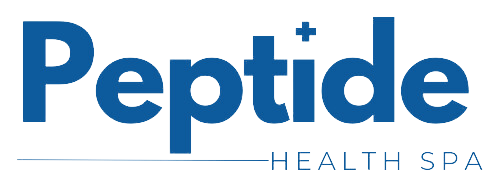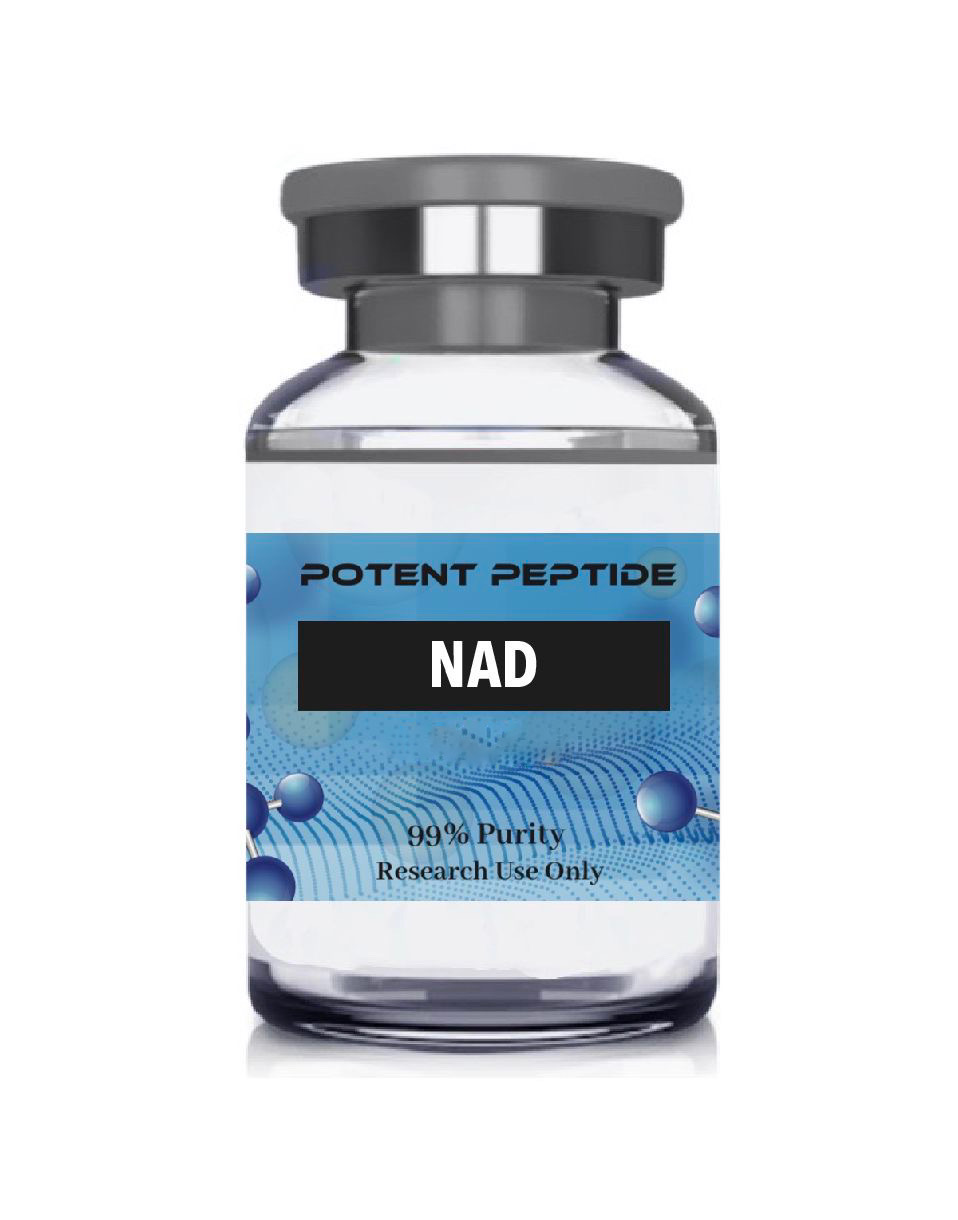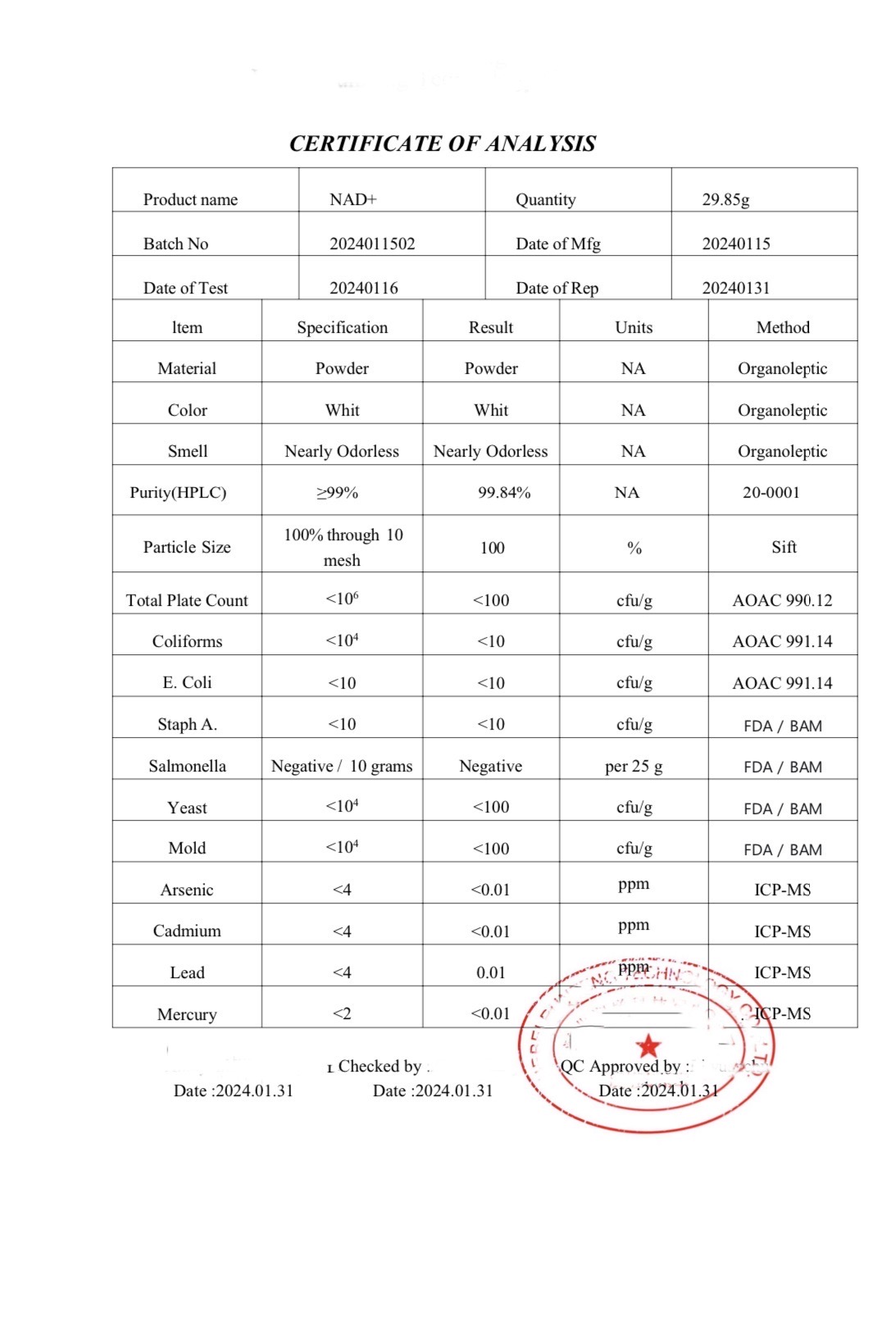Description
Nicotinamide Adenine Dinucleotide (NAD+) Peptide
Nicotinamide Adenine Dinucleotide (NAD+) is an oxidized form of NADH (Nicotinamide Adenine Dinucleotide Hydroxide). NAD+ is a component of the Electron Transport Chain (ETC), had has been suggested by researchers to act in carrying electrons within and without the cell body. The peptide has also been posited to act as a mediator for various physiological processes, such as post-translational modification of the proteins and activation/deactivation of some enzymes. It may be a critical component in maintaining cell-to-cell communication. The neurons present in blood vessels, intestines, and bladder, appear to release endogenously produced NAD+, which appears to act as an extracellular signaling molecule and bioregulator.
Specifications
SYNONYMS: Nicotinamide Adenine Dinucleotide, Beta-NAD, NAD, Endopride
MOLECULAR WEIGHT: 663.43 g/mol
MOLECULAR FORMULA: C21H27N7O14P2
NAD+ Research
NAD+ AND CELL AGING
Mitochondria serve as a platform for primary metabolic functions such as intracellular signaling and regulation of innate immunity. These processes appear directly affected by mitochondrial senescence and ultimately alter cellular metabolism, inflammation, and even stem cell activity.[1] These altogether may reduce the pace of tissue repair following damage. This illustrates the extent to which mitochondria are involved in age-related tissue and organ function decline. Researchers consider that in the course of manipulating mitochondrial activity, they may potentially slow, cease, or even reverse the process of cellular aging. A deficiency of NAD+ in the cell appears to induce a pseudo-hypoxic state which interrupts signaling within the nucleus. Studies have suggested that NAD+ supplementation may help in reversing at least some of the age-related decline in the function of mitochondria.[2] The scientists concluded that “raising NAD+ levels in old mice restores mitochondrial function to that of a young mouse in a SIRT1-dependent manner.” The mechanism underlying this property appears to involve the activation of the SIRT 1 function, whereby a gene encodes an enzyme called Sirtuin-1 (NAD+ dependent Deacetylase Sirtuin-1). Sirtuin-1 then may regulate the mediators involved in metabolism, inflammation, and the longevity of cells.[3]
NAD+ AND MUSCLE FUNCTION
Natural decline in muscle function is associated with mitochondrial senescence. Scientists consider that the decline occurs in two steps. The first, to some extent reversible, involves declined expression of mitochondrial genes. These genes appear to be responsible for oxidative phosphorylation (the process by which mitochondria produce energy). The second, irreversible, consists of a decline in genes responsible for oxidative phosphorylation in the nucleus. Mice experiments have reported an apparent step 1 reversal with the exposure of additional NAD+ before the cell progresses to step 2.[4] The mechanism behind this intervention in mitochondrial aging may involve stabilizing the activity of Peroxisome Proliferator-activated Receptor Gamma Co-activator 1-alpha (PGC-1-alpha). Studies have suggested that the effect mentioned above produced in the mitochondria may be similar to exercise on the mitochondria of skeletal muscles.[5]
NAD+ AND NEURODEGENERATIVE DISEASES
NAD+ is a cofactor that may exert a possible neuroprotective action.[6] It has been posited to do so via the improvement of mitochondrial function and reducing the production of Reactive Oxidative Stress (ROS). ROS is responsible for inflammatory changes associated with injury and degenerative changes associated with cell aging. This association provides its basis for certain neurodegenerative diseases such as Alzheimer’s, Huntington’s, and Parkinson’s disease. Research conducted on mice suggested the potential for NAD+ to protect against progressive motor deficits and the death of dopamine-producing cells in the substantia nigra.[7] According to the researchers “These results add credence to the beneficial role of NAD against parkinsonian neurodegeneration in mouse models of PD, provide evidence for the potential of NAD for the prevention of PD, and suggest that NAD prevents pathological changes in PD via decreasing mitochondrial dysfunctions.” The research findings implied that although NAD+ doesn’t appear to alleviate the symptoms, it may slow the progression if not entirely prevent the development of Parkinson’s disease.
NAD+ AND INFLAMMATION
NAMPT is an enzyme that is associated with inflammation. It appears over-expressed in certain types of cancers. An increase in the levels of NAMPT appears to correlate to NAD+ levels, and vice versa.[8] The NAMPT-associated inflammation appears to occur in cancers, obesity, type 2 diabetes, and nonalcoholic fatty liver disease. NAMPT may be a potent activator of inflammation whose levels may decrease dramatically following the introduction of NAD+.
NAD+ AND ADDICTION
Addiction has been suggested to be associated with a decline in the levels of NAD+. Addiction typically leads to significant nutritional deficiencies and cognitive deterioration. Supplementation with NAD+ may help overcome these changes and can be helpful in various addiction disorders as seen in ethanol-exposed murine models, who reportedly exhibited greater recovery rates than control models.
Disclaimer: The products mentioned are not intended for human or animal consumption. Research chemicals are intended solely for laboratory experimentation and/or in-vitro testing. Bodily introduction of any sort is strictly prohibited by law. All purchases are limited to licensed researchers and/or qualified professionals. All information shared in this article is for educational purposes only.
References
- Sun N, Youle RJ, Finkel T. The Mitochondrial Basis of Aging. Mol Cell. 2016 Mar 3;61(5):654-666. doi: 10.1016/j.molcel.2016.01.028. PMID: 26942670; PMCID: PMC4779179.
- Gomes AP, Price NL, Ling AJ, Moslehi JJ, Montgomery MK, Rajman L, White JP, Teodoro JS, Wrann CD, Hubbard BP, Mercken EM, Palmeira CM, de Cabo R, Rolo AP, Turner N, Bell EL, Sinclair DA. Declining NAD(+) induces a pseudohypoxic state disrupting nuclear-mitochondrial communication during aging. Cell. 2013 Dec 19;155(7):1624-38. doi: 10.1016/j.cell.2013.11.037. PMID: 24360282; PMCID: PMC4076149.
- Imai S, Guarente L. NAD+ and sirtuins in aging and disease. Trends Cell Biol. 2014 Aug;24(8):464-71. doi: 10.1016/j.tcb.2014.04.002. Epub 2014 Apr 29. PMID: 24786309; PMCID: PMC4112140.
- Mendelsohn AR, Larrick JW. Partial reversal of skeletal muscle aging by restoration of normal NAD⁺ levels. Rejuvenation Res. 2014 Feb;17(1):62-9. doi: 10.1089/rej.2014.1546. PMID: 24410488.
- Kang C, Chung E, Diffee G, Ji LL. Exercise training attenuates aging-associated mitochondrial dysfunction in rat skeletal muscle: role of PGC-1α. Exp Gerontol. 2013 Nov;48(11):1343-50. doi: 10.1016/j.exger.2013.08.004. Epub 2013 Aug 30. PMID: 23994518.
- Matthews RT, Yang L, Browne S, Baik M, Beal MF. Coenzyme Q10 administration increases brain mitochondrial concentrations and exerts neuroprotective effects. Proc Natl Acad Sci U S A. 1998 Jul 21;95(15):8892-7. doi: 10.1073/pnas.95.15.8892. PMID: 9671775; PMCID: PMC21173.
- Shan C, Gong YL, Zhuang QQ, Hou YF, Wang SM, Zhu Q, Huang GR, Tao B, Sun LH, Zhao HY, Li ST, Liu JM. Protective effects of β- nicotinamide adenine dinucleotide against motor deficits and dopaminergic neuronal damage in a mouse model of Parkinson’s disease. Prog Neuropsychopharmacol Biol Psychiatry. 2019 Aug 30;94:109670. doi: 10.1016/j.pnpbp.2019.109670. Epub 2019 Jun 17. PMID: 31220519.
- Garten A, Schuster S, Penke M, Gorski T, de Giorgis T, Kiess W. Physiological and pathophysiological roles of NAMPT and NAD metabolism. Nat Rev Endocrinol. 2015 Sep;11(9):535-46. doi: 10.1038/nrendo.2015.117. Epub 2015 Jul 28. PMID: 26215259.



Reviews
There are no reviews yet.